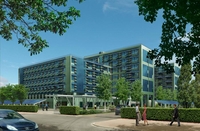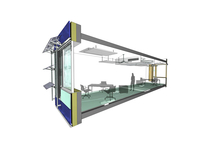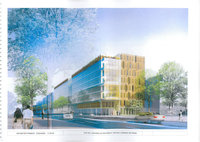TRIBU: Towards an environmental requirement

Alain Bornarel very clearly targets the fundamental stakes and the responsibility of professionals involved in construction and development of the region as far as control of non-renewable resources (energy, water, raw materials, soil, etc.), reduction of greenhouse effect gases, and protection of biodiversity and natural media (living ecosystems, water tables, air quality, etc.) are concerned. In a crisis context, energy savings are obviously not the only concerns of a sustainable development approach, even if their rarefaction and price, combined with climatic upheavals, make them extremely important objectives.
Sustainable development, but to what level?
On the scale of a building, it is not just a question of making "low consumption boxes, he tells us: "We are concerned with taking care with the quality of lighting and natural ventilation, and are attentive to health risks and grey energy in materials, in other words energy consumed in manufacturing them. We don’t think about it much, but for example 36 times as much energy is needed to produce an aluminium frame than to produce a wood equivalent." The environmental strategy is just as important on the scale of a town or a region. For the École Centrale graduate, manager of the TRIBU company, the question of the size of the region to be considered for better energy performance has not been answered: "Shouldn’t we consider an entire island rather than simply each building separately?", he asks. Bioclimatics must be combined with town planning. And the quality of environments and management of travel modes remain investigation themes that have still not been developed sufficiently. Faced with Local Town Planning Plans that always demand larger numbers of parking spaces, Alain Bornarel appears for example to reply that "for half the price of one parking space per home, we could pay the extra cost of a BBC building."
Advanced technical contributions
TRIBU is exploring innovative devices beyond the standard approach, in a field that is expanding very quickly. For example, Jean Jaurès high school at Saint-Clément-de-Rivière in the Montpellier region, where reflectors on the Southern facades combine summer comfort and uniform indoor lighting with an FJ (the light factor) of 2% over the entire building. The natural ventilation from the outside is assisted by Australian windmills for most rooms (there are no manufacturers in France) and is controlled by a damper slaved to the air velocity.
For the Meudon "Green Office" office building project, and also for IGN’s Saint-Mandé head office, Edith Akiki and Alain Bornarel explain uncompromisingly that target energy consumptions must take account of all uses, including data processing and computers: "50 kWh/m²/year only applies to a small number of usages and final global invoices are much higher." During the design within the framework of close cooperation with the Atelier 2M architects, the "Green Office" project is directly aimed at a zero energy balance. This is why half of all the floors will be less than 13.50 m wide so that light can enter the building efficiently, while floors wider than 18 m will have a central core entirely dedicated to auxiliary or service rooms. Natural summer ventilation, unlike winter double flow, will be provided by motor-driven openings on the facades. The architectural innovation in indoor space in offices is the lack of absorbent technical false ceilings. This is to benefit from the natural inertia of materials, rather than for aesthetic reasons. Studies have shown that high quality acoustics can be obtained by covering only 30% of the surface of concrete slabs, so that 70% can be used for storage of heat and cold.
But there are still too few genuinely-high performance projects. TRIBU does not conceal the fact that a great deal of work remains to be done to train designers and contractors, although design techniques for a building consuming 50 kWh/m²/year are now perfectly controlled. "Insulation on the outside is always difficult to apply using standard practices", says Edith Akiki. Although the world of new construction is at the start of a genuine revolution, transformation of existing buildings is difficult because of investment problems. Nevertheless, the trend towards making existing buildings sustainable is a fundamental challenge for energy savings on a significant scale. Alain Bornarel believes that existing buildings will eventually follow the trend; new construction must continue to open up the technical path and show an example: "The performance of a project to be delivered in 2 or 3 years, or even longer for town planning projects, should not be lower than the BBC level, which will most likely become the standard in 2012."
• THPE: Very High Energy Performance Building, corresponds to RT2005 -20%.
• BBC: Bâtiment Basse Consommation (Low Consumption Building), corresponds to 50 kWh/m²/year. For comparison, RT2005 corresponds to a consumption of 100 kWh/m²/year.
• BEPAS: Passive buildings with needs of less than 15 kWh/m²/year.



